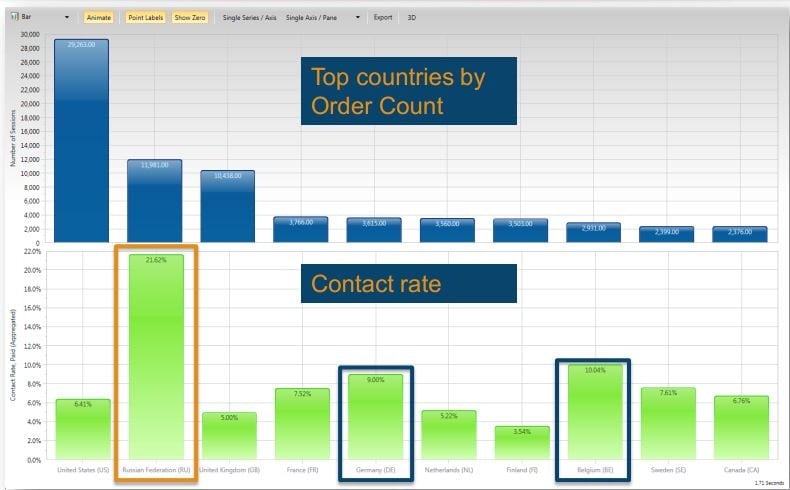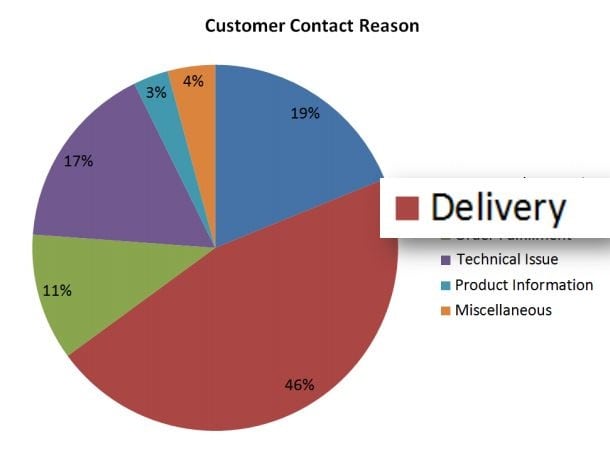Inefficiencies in customer service offerings cost businesses millions of dollars each year. To improve customer service, companies should monitor regional orders and compare them to those regions’ customer contact rates. They should also monitor the reasons why customers are contacting them, and which contact methods customers use.
Contact rates by region
The Internet made it simpler to deliver products and services to customers around the globe. The challenge with selling to an international market is providing adequate support to all of your customers. The graph below represents a composite software company’s monthly performance in terms of order volume and customer contact rates. You’ll notice that Russian customers provide a significant amount of orders, but they also provide a disproportionate amount of customer service contacts.
An acceptable customer contact rate hovers between six and eight percent. In the example above, Russian customers generate a 21 percent contact rate, bringing almost 700 more contacts per month than the U.S. customers who generate three times as many orders. It’s clear from the graph that these Russian customers are experiencing challenges that U.S. customers are not. What can be done to reduce the rate of these customer contacts?
Customer contact reasons
Part of the process of reducing contact rates is understanding why customers are contacting you. This is just as important as understanding which customers are contacting you.
To discover why customers contact you, you’ll need a database for each customer contact that includes a record of the reasons behind each contact. Your database should eventually be able to find the answers to questions like:
- Are customers receiving their orders or not?
- Are they having technical problems installing or using your product?
- Are they confused about a bill on their bank account statement?
- Do they want a refund?
The composite graph below breaks down the various reasons customers engage with software companies. In this case, it’s clear that delivery inquiries are a major issues, along with technical support and product information issues.
Once you know which customer segment is increasing your contact rate and the reason these customers are contacting you, it’s time to decide the best way to optimize your offering.
How to reduce customer contact rates
One way to handle escalating contact rates would be to hire more staff for foreign language contacts. But this is a stop gap measure at best and does not address the underlying cause of the spike in contacts. Also, finding staff to handle the different languages your customers speak can be time consuming and fairly expensive.
Instead, try reducing contacts by improving customer service on your website, shopping cart, confirmation page and help section of your product.
Focus on providing information regarding the issues you uncovered when analyzing contact reasons. Most importantly, focus on localizing texts for your highest volume markets. This includes content for all the elements of your shopping cart, confirmation page and customer support section of your website, such as:
- Contact information
- FAQs
- Download instructions
- Activation instructions
- Login instructions for SaaS product
- Payment information
- Refund policy
Contact methods
After identifying why certain regions generate an inordinate amount of contacts and then localizing your customer service offering for those regions, it’s also important to understand the costs and benefits of your various contact methods. A fully functioning customer service department that responds to hundreds of questions and comments a day should minimally be equipped with:
- A phone number – Phone calls are important because they are much more communicative than an email or website. A two minute phone call can often provide customers clearer information than a chain of a dozen emails.
- An email address – Emails are useful for providing customers a variety of information that is easily stored and accessed. With software purchases, emails are doubly important as they often contain access to the software product itself.
- A website – Your website should include a focus on customer service by including a page with contact information, a list of the hours of operation, and estimates of response times. This is a highly efficient and cost effective tool for customer service. The more customer service information you incorporate into the website, the more you can reduce customer contacts. Your website is probably the most cost-effective tool in your customer service arsenal. It therefore should provide any information that a representative might give to a customer on the phone or by email. Just be cautious about being too comprehensive. Too much helpful information can be turn out to be not helpful at all.
- Social networks – These include business pages on social networks like Twitter, Google+, LinkedIn and Facebook. They are better used as reference pages than as a direct channel to deal with customer inquiries. Think of your social channels a table of contents for all your marketing material. As far as customer service, social networks are useful as a method for pointing to more efficient channels like the website, email or phone.
- Staff – Ultimately, a sufficient amount of staff is required to operate all these tools efficiently.
Customer Retention
Clever business-minded people know that the key to long-term profitability is customer retention. If you want customers to remain loyal to your brand, you need to provide them excellent customer service.
You cannot afford to throw away the revenue from customers because of poor customer service. Reduce your customer contacts and churn rates by localizing customer service channels for regions that bring in significant revenue and above average contact rates.
Joe Schnaufer is the global director customer support at cleverbridge.

